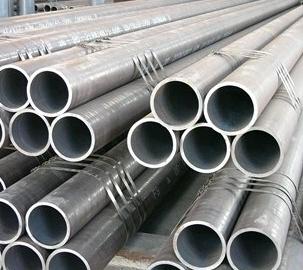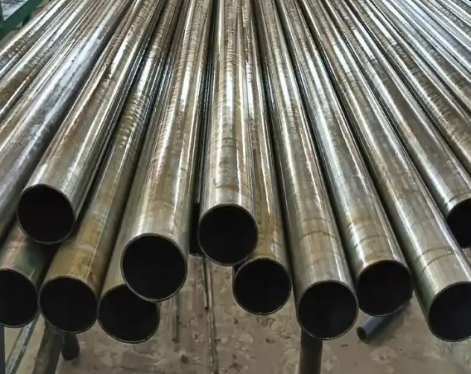The eddy current detection of seamless steel pipe is to use the principle of electromagnetic induction to excite the probe coil with high-frequency sine wave current. When the probe is close to the metal surface, the alternating magnetic field around the line pattern will generate an induced current on the metal surface. For flat metal, the flow direction of the induced current is a circle concentric with the coil, which is called an eddy current in the shape of a vortex.
Eddy current testing method for seamless steel pipe
(1) Penetrating eddy current testing
Through-through eddy current flaw detection is a method widely used in eddy current flaw detection of steel pipes. Generally, most steel pipes with a diameter of less than 180mm adopt this flaw detection method. It is characterized by fast detection speed, can realize the inspection of the entire steel pipe surface, and the adjustment and operation of the equipment are relatively simple.
The commonly used through-type eddy current flaw detection equipment consists of detection part, including eddy current flaw detector, detection coil and magnetic saturation device. Auxiliary parts, including mechanical parts, such as loading and unloading benches, transmission rollers, detection hosts, control systems, demagnetization and marking devices, etc.
(2) Rotating point probe is eddy current flaw detection
Rotating point probe eddy current flaw detection is an automatic flaw detection method in which the point probe network rotates around the steel pipe and the steel pipe moves straight. The point probe is placed in the rotating head, and the probe rotates to scan the steel pipe surface.
Eddy current flaw detection method for multi-diameter seamless steel pipes
The detection sensitivity of point eddy current flaw detection is very high, and it has a high detection rate for cracks and fold defects distributed along the steel pipe axis; in addition, point eddy current detection can also suppress ambient temperature and workpiece transmission vibration. More importantly, the form of the point eddy current probe can adapt to the flaw detection requirements of steel pipes with different diameters.
(1) First, according to the actual situation of the production line, determine the flaw detection method that the steel pipe spirally rotates along the production line and the probe is fixed. While rotating the steel pipe forward, bring the point probe close to the steel pipe surface to scan the entire outer surface.
(2) Determine the structure of the flaw detection system. First put the six-channel eddy current probe into the probe trolley, and adjust the probe trolley to meet the requirements of the diameter of the steel pipe to be tested by adjusting the screw. Then use the cylinder to push the fine adjustment method so that the probe trolley detection probe is always tightly pressed on the workpiece. To detect the surface of the workpiece, install a pair of universal wheels at both ends of the probe station to keep a certain distance from the workpiece to be detected.
(3) Determine the number of probes. The point probe flaw detection method needs to use multiple detection probes to increase the scanning distance and improve the detection speed. Eddy current point probes are generally small in size and high in detection sensitivity, but at the expense of detection speed. Increasing the coverage of the probe's detection area can increase the detection speed, but the detection sensitivity will decrease.

Advantages of eddy current testing for seamless steel pipes
(1) The flaw detection result can be directly output by electrical signal, which is convenient for automatic detection;
(2) Due to the non-contact method, the flaw detection speed is very fast;
(3) Suitable for flaw detection of surface defects.
Disadvantages of eddy current testing for seamless steel pipes
(1) Defects in deeper parts under the surface of seamless steel pipes cannot be detected;
(2) It is easy to generate cluttered signals;
(3) It is difficult to distinguish the type of defect directly from the detected display signal.
After continuous improvement and development, eddy current flaw detection has become one of the inspection methods recognized at home and abroad that can replace hydrostatic testing. Eddy current flaw detection is widely used and is applied to conductive materials. Almost all steel pipes, whether ferromagnetic or non-ferromagnetic, generally have a diameter greater than 2mm and a wall thickness of not less than 0.1mm. Eddy current flaw detection can be used. At present, it is especially used in online or offline automatic flaw detection of pipes and bars, and has the characteristics of high detection speed.
Eddy current testing method for seamless steel pipe
(1) Penetrating eddy current testing
Through-through eddy current flaw detection is a method widely used in eddy current flaw detection of steel pipes. Generally, most steel pipes with a diameter of less than 180mm adopt this flaw detection method. It is characterized by fast detection speed, can realize the inspection of the entire steel pipe surface, and the adjustment and operation of the equipment are relatively simple.
The commonly used through-type eddy current flaw detection equipment consists of detection part, including eddy current flaw detector, detection coil and magnetic saturation device. Auxiliary parts, including mechanical parts, such as loading and unloading benches, transmission rollers, detection hosts, control systems, demagnetization and marking devices, etc.
(2) Rotating point probe is eddy current flaw detection
Rotating point probe eddy current flaw detection is an automatic flaw detection method in which the point probe network rotates around the steel pipe and the steel pipe moves straight. The point probe is placed in the rotating head, and the probe rotates to scan the steel pipe surface.
Eddy current flaw detection method for multi-diameter seamless steel pipes
The detection sensitivity of point eddy current flaw detection is very high, and it has a high detection rate for cracks and fold defects distributed along the steel pipe axis; in addition, point eddy current detection can also suppress ambient temperature and workpiece transmission vibration. More importantly, the form of the point eddy current probe can adapt to the flaw detection requirements of steel pipes with different diameters.
(1) First, according to the actual situation of the production line, determine the flaw detection method that the steel pipe spirally rotates along the production line and the probe is fixed. While rotating the steel pipe forward, bring the point probe close to the steel pipe surface to scan the entire outer surface.
(2) Determine the structure of the flaw detection system. First put the six-channel eddy current probe into the probe trolley, and adjust the probe trolley to meet the requirements of the diameter of the steel pipe to be tested by adjusting the screw. Then use the cylinder to push the fine adjustment method so that the probe trolley detection probe is always tightly pressed on the workpiece. To detect the surface of the workpiece, install a pair of universal wheels at both ends of the probe station to keep a certain distance from the workpiece to be detected.
(3) Determine the number of probes. The point probe flaw detection method needs to use multiple detection probes to increase the scanning distance and improve the detection speed. Eddy current point probes are generally small in size and high in detection sensitivity, but at the expense of detection speed. Increasing the coverage of the probe's detection area can increase the detection speed, but the detection sensitivity will decrease.

Advantages of eddy current testing for seamless steel pipes
(1) The flaw detection result can be directly output by electrical signal, which is convenient for automatic detection;
(2) Due to the non-contact method, the flaw detection speed is very fast;
(3) Suitable for flaw detection of surface defects.
Disadvantages of eddy current testing for seamless steel pipes
(1) Defects in deeper parts under the surface of seamless steel pipes cannot be detected;
(2) It is easy to generate cluttered signals;
(3) It is difficult to distinguish the type of defect directly from the detected display signal.
After continuous improvement and development, eddy current flaw detection has become one of the inspection methods recognized at home and abroad that can replace hydrostatic testing. Eddy current flaw detection is widely used and is applied to conductive materials. Almost all steel pipes, whether ferromagnetic or non-ferromagnetic, generally have a diameter greater than 2mm and a wall thickness of not less than 0.1mm. Eddy current flaw detection can be used. At present, it is especially used in online or offline automatic flaw detection of pipes and bars, and has the characteristics of high detection speed.









